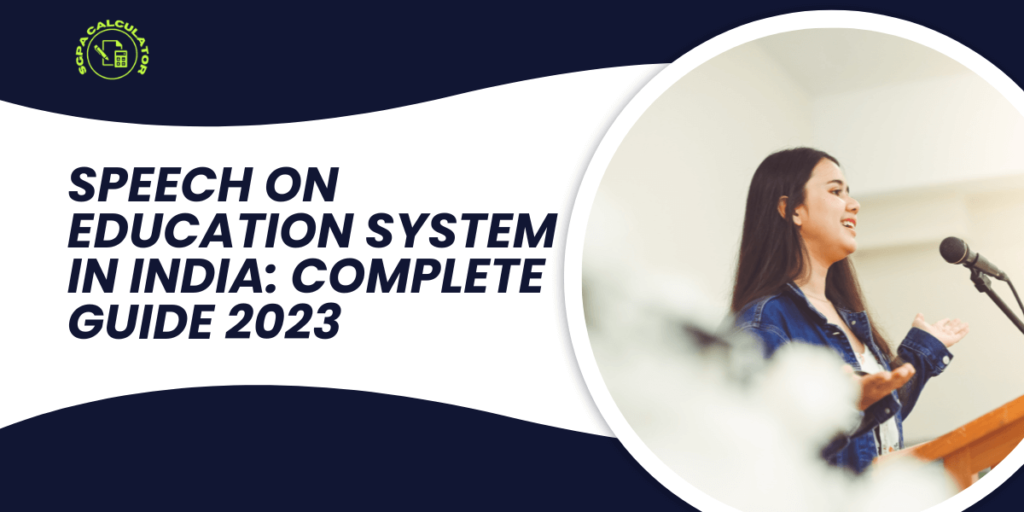India’s educational system has a long and rich history, dating back thousands of years, and has attracted scholars from all over the world to historic centres of learning like Takshashila and Nalanda. The system has, however, faced several difficulties over time, reflecting the changing nature of a diverse and complicated country. This article examines the development and present-day condition of speech on education system in India, noting its successes and addressing the ongoing difficulties it encounters.
Historical Summary
India’s educational system has a rich history, one that includes internationally famous academic institutions. Institutions like Takshashila and Nalanda promoted an atmosphere of intellectual curiosity and scholarly research. Students from all around the world came to these universities to study a variety of subjects, from astronomy to medicine, philosophy to mathematics. Since a wide spectrum of people had access to education, the spread of knowledge was not restricted to a single social class.
The Colonial Era and the Modern Educational System
India’s educational system was substantially impacted by colonialism. To meet their administrative demands, the British created an organised educational approach that placed an emphasis on learning English and encouraged students to pursue disciplines that matched their interests. While this did offer some degree of formal education, it also had the unintended consequence of undermining traditional knowledge systems and excluding indigenous languages and cultures from the curriculum. The learning student used SGPA Calculator systems.
India started a quest to rebuild and restructure its educational system after obtaining independence in 1947. The government understood that it needed to serve a sizable and diverse people, so it developed a number of measures to increase access to education, lower the illiteracy rate, and progress science and technology. To improve higher education in the nation, the Indian Institutes of Technology (IITs), Indian Institutes of Management (IIMs), and other prestigious institutions were founded.
Progress made by the educational system
India’s educational system has made a number of strides. The nation has a strong higher education system with outstanding universities that have turned out scholars and professionals who are well-known around the world. The focus on STEM education has produced a continual flow of knowledgeable people who have made contributions to numerous areas on a national and worldwide level.
In addition, India’s emphasis on education has resulted in a considerable decline in illiteracy rates over time. The Right to Education Act, passed in 2009, elevated access to education nationwide for kids aged 6 to 14 by establishing it as a basic right. This regulatory framework attempted to close the gap between various socioeconomic groups and guarantee that the underprivileged groups in society received an education.
Read Our Post: Central Board of Secondary Education
Challenges the Education System Faces
Despite these successes, a number of obstacles prevent India’s educational system from reaching its full potential.
Quality Disparities: While quality education is available in metropolitan areas, it is frequently lacking in rural areas due to inadequate facilities, a shortage of qualified teachers, and a lack of funding. Social and economic inequality is made worse by this disparity.
Rote Learning vs. Critical Thinking: The system’s strong emphasis on memorization and rote learning hinders pupils’ ability to think critically, creatively, and solve problems. Their capacity to respond to problems in the actual world is hampered by this.
Outdated Curriculum: A lot of the time, the curriculum is still antiquated and does not give students the skills they need for today’s workplaces. Integrating practical, industry-relevant information into the educational framework is becoming more and more important.
Lack of trained Teachers and Training: The quality of education is impacted by the lack of trained teachers, particularly in rural areas. To adapt to changing teaching approaches, there is also a need for ongoing teacher training.
Evaluation and Assessment: The emphasis on exams puts a lot of pressure on students and promotes rote memorization. Focusing on ongoing assessment and skill evaluation would encourage all-around learning.
Lack of Vocational Education: Because academic pursuits predominate in the educational system, there is little place for vocational education. This hinders the growth of talents relevant to different businesses.
Digital Divide: The digital divide still exists and prevents remote communities from having equal access to online education. The COVID-19 epidemic made clear how critical it is to have a digital infrastructure and educate people in using it.
Read Our Blog: Rishi Sunak Education
Taking Action to Improve
Taking on these problems demands a multifaceted strategy:
Curriculum Reform: Reforming the curriculum on a regular basis is crucial in order to include interdisciplinary learning, critical thinking, and practical skills.
Teacher Empowerment: Improving the quality of education can be accomplished by giving teachers the right training, competitive pay, and incentives.
Focus on Holistic Learning: Holistic learning should be emphasised, and this can be done by promoting project-based learning, experience learning, and extracurricular activities.
School for All: It is essential to guarantee underprivileged communities’ equal access to school through improved support systems, scholarships, and infrastructure.
Integration of Vocational Education: Including vocational training in regular classes can give students job-ready skills.
Digital Infrastructure: Closing the digital divide and advancing digital literacy will improve access to high-quality education.
Conclusion
Since its ancient beginnings, India’s educational system has advanced significantly, demonstrating the country’s adaptability and tenacity. Despite having made great progress, it still faces formidable obstacles. India can develop an educational system that enables its population to excel on the world arena while preserving its unique cultural legacy by focusing on quality, inclusivity, and a learner-centric approach. The situation calls for a thorough revision that takes access, quality, and relevance into account. The only way for India’s educational system to completely realize its potential and open the door to a better future is via concerted efforts and ongoing changes.





